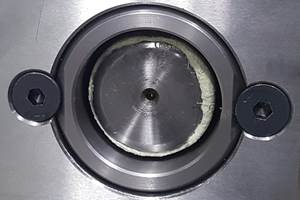Blow Molding Simulation: Ready for Prime Time?
Efforts have been made to simulate the extrusion blow molding process for at least a decade, but actual use has been slow to take hold.
Efforts have been made to simulate the extrusion blow molding process for at least a decade, but actual use has been slow to take hold. Sources attribute this lag to fears of “computers replacing people” in tool design, limited availability of commercial blow molding simulation software, relatively high software cost, and the absence of powerful forces in favor of its adoption.
Yet today, leaders of SPE’s Blow Molding Div. see the tide changing, at least in leading-edge sectors of the blow molding business. They credit the software’s improved ability to predict parison extrusion and inflation, die swell, and other behaviors and the resulting delivery of optimized parts with low weight and tailored wall thickness.
Heightened interest in simulation is reflected in plans for the SPE’s next blow molding technical conference, set for Sept. 22-23 in Boucher ville, Que. The event emphasizes simulation and will take place at the Industrial Materials Institute of the National Research Council Canada (IMI/NRCC), which supplies BlowView simulation software for blow molding. Gathering momentum?
“One driver behind simulation is the rising cost of failure with traditional experience-based, trial-and-error methods,” says John Perdikoulias, president of Compuplast Canada, which supplies B-SIM simulation software. He says simulation is increasingly being used for large automotive parts like ducts and fuel tanks, as well as odd-shaped bottles. Simulation reportedly bypasses the need for prototype tooling and cuts mold cost and delivery time.
Compuplast has sold or licensed B-SIM software to about 15 companies worldwide. Requests for quotes on B-SIM purchases and simulation services are both up by around 300% from a year ago, Perdikoulias claims.
Bob Jackson, president of Jackson Machinery, a supplier of accumulator-head machines in Port Washington, Wis., says the trend to increased part complexity favors simulation. He says parts like the latest fuel tanks and a Folgers barrier coffee container are made feasible by simulation. That multi-layer coffee canister is unusual in shape and geometry and has integrated finger grips. Blow molders of fuel tanks, like Vitek LLC in Detroit, say simulation software is a prerequisite for being able to tailor wall thickness for maximum strength at the lowest possible weight.
Jackson calls blow molding simulation “a work in progress” that has definite limits in its current ability to solve problems. Yet he says that declining costs of computing and steadily improving software capabilities mean that broader use of simulation software by mainstream blow molders may be just around the corner.
David Tekamp, principal of engineering consultant Stress Engineering Services (SES), says rapid improvements have been made in recent years in the accuracy and cost-effectiveness of hardware and software for blow molding simulation. “In the mid-1990s, it took at least a day to simulate even simple designs, whereas today more complex ones can be done in hours.” SES offers blow molding simulation services for an hourly fee. One its recent projects involved a family of three bottle designs. The firm performed thickness and structural analysis and complex feature definition in three weeks at a cost of around $30,000. Tekamp says payback is speedy, given bottle weight savings and reduced tool costs.
Less need for designers?
For decades, blow molding has been well served by an experienced pool of designers. But industry sources cite reports indicating that up to 50% of plastics mold and part designers could retire in the next five years in parts of the industrialized world such as North America. Simulation might help fill the gap by increasing the productivity of the remaining pool of designers. It also might give less experienced designers a head start on the job. Jonathan Meckley, an assistant professor at Pennsylvania State University in Erie, discounts the view that simulation reduces demand for skilled designers and technicians. However, he believes more of those skills can be acquired nowadays in school. Meckley is responsible for Penn State’s extensive training programs in blow molding simulation, which employ IMI’s BlowView. He argues that designers now coming of age will require more expertise in computing and polymer science than the previous generation. “Simulation simply transfers trial-and-error discovery to the computer at an earlier point in the design phase, but it does so in a way that allows tools to be cut in fewer steps at less cost,” says Meckley.
Perdikoulias says a new generation of designers more attuned to simulation is making an impact. He calls for blow molders to adopt simulation as a deliberate strategy and to ensure that all parties involved—including the designer, moldmaker, and OEM—have a stake in its success. He also notes that simulation is not just a matter of software, but requires an experienced hand. “The more simulation is used, the better the outcome.”
Related Content
Best Methods of Molding Undercuts
Producing plastics parts with undercuts presents distinct challenges for molders.
Read MoreBack to Basics on Mold Venting (Part 1)
Here’s what you need to know to improve the quality of your parts and to protect your molds.
Read MoreWhat You Need to Know About Leader Pins and Bushings
There’s a lot more to these humble but essential mold components than you might suspect. Following the author’s tips could save much time, money and frustration.
Read MoreHow to Mount an Injection Mold
Five industry pros with more than 200 years of combined molding experience provide step-by-step best practices on mounting a mold in a horizontal injection molding machine.
Read MoreRead Next
Processor Turns to AI to Help Keep Machines Humming
At captive processor McConkey, a new generation of artificial intelligence models, highlighted by ChatGPT, is helping it wade through the shortage of skilled labor and keep its production lines churning out good parts.
Read MoreHow Polymer Melts in Single-Screw Extruders
Understanding how polymer melts in a single-screw extruder could help you optimize your screw design to eliminate defect-causing solid polymer fragments.
Read MorePeople 4.0 – How to Get Buy-In from Your Staff for Industry 4.0 Systems
Implementing a production monitoring system as the foundation of a ‘smart factory’ is about integrating people with new technology as much as it is about integrating machines and computers. Here are tips from a company that has gone through the process.
Read More






.png;maxWidth=300;quality=90)


















